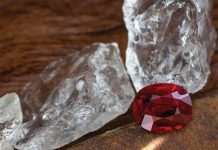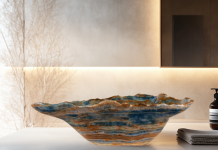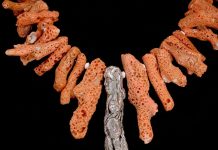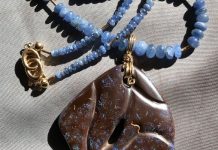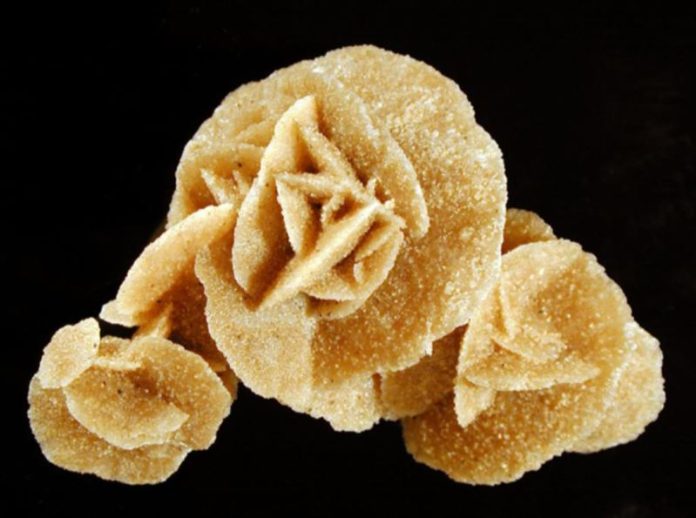
Desert rose crystals occur in many areas, but their premier locality is Chott el-Djerid (shot-el-JEER-id) in the Sahara Desert in the North African nation of Tunisia. This barren yet strangely beautiful seasonal lake, one of the world’s most unusual mineral localities, has even found its way into literature and the movies. Known as “rock roses” and “gypsum roses,” these aptly named clusters of bladed gypsum crystals closely resemble rose petals.
Chott El-Djerid
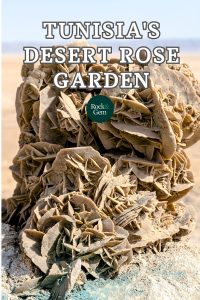
The Arabic word “chott” refers to desert lakes that fill in the winter but are dry in summer. The translation of “Chott el-Djerid” as “Lake of the Land of Palms” is misleading: While date palms do thrive in nearby irrigated areas, Chott el-Djerid itself is completely devoid of vegetation. Covering 2,700 square miles, it is larger than Utah’s Great Salt Lake.
Chott el-Djerid is a depression of eolian (wind) origin. Since the recent Ice Ages, prevailing winds have swept away about 100 feet of surface sediments to place the lake bottom 60 feet below sea level. As a closed basin, water can enter the depression, but not exit. Although regional rainfall is only a few inches per year, it nevertheless fills the lake in winter. With the arid climate and temperatures that reach 120°F, evaporation is rapid and the lake is almost completely dry by midsummer.
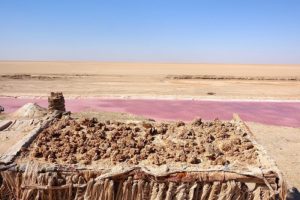
Photo courtesy Wikimedia Commons
Tunisia’s Desert Rose Crystals
The water that enters Chott el-Djerid is rich in soluble minerals such as gypsum (hydrous calcium sulfate) and halite (salt, sodium chloride). Over several millennia, annual replenishment-evaporation cycles have created a lake bed consisting mostly of gypsum, halite and fine grains of quartz sand.
When summer evaporation concentrates the lake water to saturation, gypsum and halite crystallize within the moist lake bed sediments. The gypsum precipitates as bladed crystals which, over many years, develop as radiating clusters called “desert roses.”
The “petals” of desert rose crystals consist of substantial amounts of sand. When this sand is heavily included with particles of hematite (iron oxide), desert roses have dark, reddish-brown colors; sand with lesser amounts of hematite produces lighter-colored desert roses.
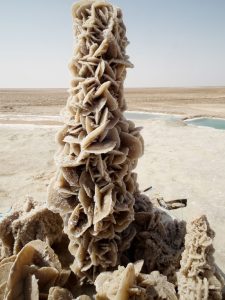
Photo courtesy Wikimedia Commons
A Rose is Not Always a Rose
In her 1913 poem “Sacred Emily,” Gertrude Stein wrote “a rose is a rose is a rose,” meaning simply “things are what they are.” But that’s not quite true when it comes to gypsum desert roses, which vary greatly in size, color, and the separation and definition of their “petals.”
Of all desert roses, those from Chott el-Djerid have the greatest visual appeal. Most are about two inches in diameter, but four-inch specimens are not uncommon. Exceptional specimens can measure two feet in diameter and weigh more than 100 pounds.
Desert roses from other localities have a high sand content, rust-like colors, blocky shapes, crudely formed “petals,” and coarse textures. But those from Chott el-Djerid have a low content of fine, light-colored sand and more gypsum, which combine to create lighter colors and a hint of luminosity. The sharp-edged, finely developed, bladed crystals that form the “petals” give each desert rose an almost-lifelike appearance. As a final touch, an unusual amount of colorless, crystalline halite imparts a subtle sparkle.
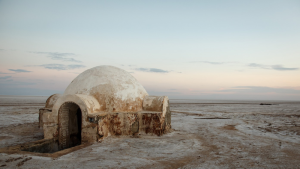
Photo courtesy Wikimedia Commons
A Desert History
Scholars of classical Greek mythology believe that Chott el-Djerid is the ancient lake Tritonis, the birthplace of the goddess Athena and a site visited by Jason and the Argonauts in their quest for the Golden Fleece. In much more recent times, indigenous Berber nomads collected and traded desert roses across much of North Africa.
The plot of Jules Verne’s 1903 novel Invasion of the Sea is based on an actual French colonial plan to dig a canal from the Mediterranean Sea to flood Chott el-Djerid and create a “Sahara Sea.” Interestingly, that plan is still being considered today.
Chott el-Djerid’s desert rose crystals attracted little outside attention until Tunisia became a World War II battleground and thousands of American and British troops acquired them as souvenirs. By the 1950s, when mineral collecting took off in North America and Europe, desert roses were already a popular collectible.
Millions of moviegoers around the world have seen Chott el-Djerid without realizing it. In the Star Wars movie franchise, it was the filming location for the Lars Homestead on the desert planet Tatooine where young Luke Skywalker was raised. Creator and director George Lucas had chosen Chott el-Djerid for its “otherworldly” appearance and built a domed structure to represent the entrance to Luke’s underground homestead. And today, 48 years later, the structure still stands as a remote, yet often visited tourist site.
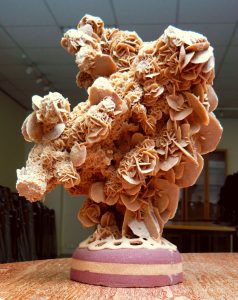
Photo courtesy Wikimedia Commons
The “Rose Garden” Today
As Tunisia’s iconic souvenir, Chott el-Djerid desert roses are sold at most of the nation’s markets and tourist venues. Collecting them commercially is a cottage industry for residents of nearby towns. Each year, tons of desert roses are exported to North America and Europe for sale at rock shops and gem and mineral shows.
Today, desert rose crystals are as popular as ever and Chott el-Djerid itself has become an adventure-travel destination. The stark beauty of the vast seasonal lake is accentuated when its water takes on bright orange, pink, and purple colors due to concentrations of halophilic (salt-loving) bacteria—an added element of intrigue that further enhances the otherworldly beauty of Tunisia’s “rose garden.”
This story about Tunisia’s desert rose crystals previously appeared in Rock & Gem magazine. Click here to subscribe. Story and pictures by Steve Voynick.


